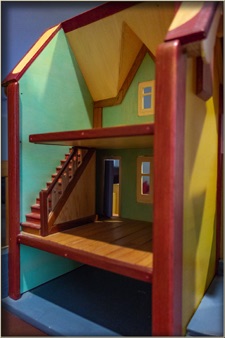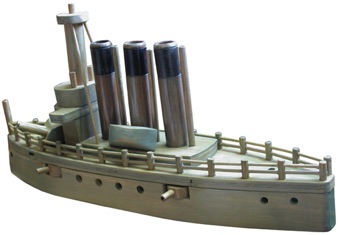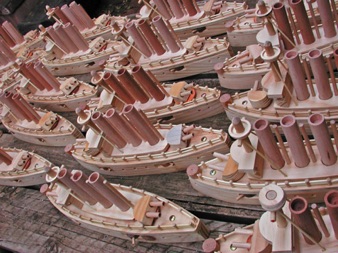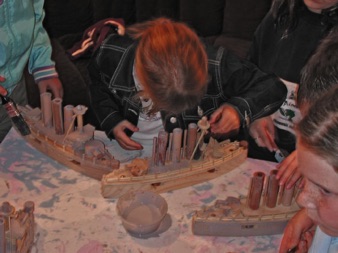The Toys in this gallery include:
The Castle Dolls' House - Neighbouring Dolls' Houses - Robot Puppet,
Battleships - Swing-around Aeroplane
The Castle Dolls' House is the largest and most ambitious of these projects and has the greatest range of wood-art and graphics techniques employed in its making. It is the most recent of the toys I have designed and made and it was a gift for my second youngest grand daughter. It is constructed mostly from meranti timber and plywood. Meranti was the cheapest and most readily available, not-too-difficult-to-shape-and-carve timber available locally.
The Castle Dolls' House features an opening draw bridge at the front and the spiral-staircase swings outward for more interior access. The 840 mm high Castle dolls' House can be set against a wall or in a corner and does not need to be moved for play, because the main tower is on a 'lazy-Susan' turntable which alows alternating access to the front or back.
Though labour intensive, a fairly large project for a toy and employing a range of skills, I believe this project is one that a woodworking beginner could successfully tackle, with a little determination and effort. The most difficult part was the design work. The 'carving' and the joining of sections was fairly elementary and required few specialised but commonly owned tools.
If I can find time for the considerable task of re-making the project. Not intuitively as I did at first, but with full documentation, accurately drawn plans and measured patterns. Then with those plans and instructions to work from, I am certain most people, with moderate skills and or determination, have a very good chance of sucess.
The Neighbouring Dolls' Houses were built for my two oldest grand daughters when they were younger. These detachted houses share a common base, adjoining street front and side lane with a gate.
The Robot Puppet is a simple five-string marionette design, but made with specially selected timbers of vibrant natural colour, finely finished, polished and assembled with polished hardware components.
The battleships were assembled by a group of chilren, as a craft project. Each, already-sanded, component part was given a 'final' sand by the children. Sanded by them, to what would be deemed, an acceptable level by the children's supervisors, who were monitoring the activity to fit within a co-ordinated schedule. This was the greater part of the childrens' work on the project. Then, with assistance, children assembled the ships in stages, from pre-shaped, tight fitting parts, over a number of weekly sessions, using just as much white glue as could be delivered from the end of a tooth-pick. This ensured a tidy finish for the all-over, watered-down, grey paint job, applied prior to an adult-applied clear polyurethane spray finish.
The Swing-around Aeroplane was constructed from laminated sheet pieces of balsa wood. The plane was tethered with a length of cotton string through a small glued-on washer at one wing-tip. An over-sized, high-pitched propeller, carved from red cedar, spins freely on a suitable, bulb-ended pin, glued into the nose. The fin was then glued a little askew on the tail-plane with its leading edge pointing a bit toward the tethered wing tip. This turns the plane a little outward from its arc of travel, keeping the string taught. The propeller rotates a bit noisily, to good effect, if the hole is loose enough, and its being oversize causes enough drag to make, only slow circuits and soft impacts possible, especially as the length of string increases.

























